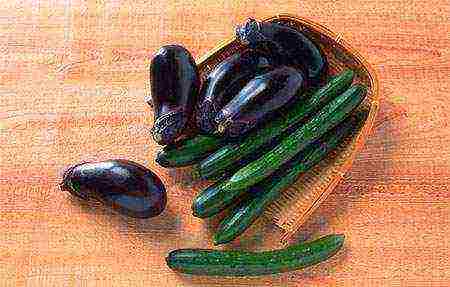Content
- 1 Feeding turkeys
- 2 Keeping turkey poults
- 3 Basic requirements for the premises
- 4 Fattening for young meat
- 5 Arrangement of the place of detention
- 6 Raising chicks
- 7 Care of grown turkeys
- 8 Turkey meat breeds
- 9 Financial expenses
Diet turkey meat is useful for children and adults, and especially for people prone to allergies. Poultry meat has a lot of taste advantages, and everything that is grown at home will be an environmentally friendly product and can be used for food without thinking about the dangers to health.
Growing turkeys for meat at home
Feeding turkeys
The very first food for them will be a boiled egg, carefully chopped, about 5 g per baby. For a variety of feeding, you can offer them homemade or store cheese, as well as millet. In the first three days, the chicks are fed in small portions, but often (after 3 hours) well-cooked cereal porridges. Chicks need to mix in food with grated carrots and finely chopped grass or green onion feathers, which is very useful for them as a fight against intestinal parasites. In the future, you need to observe which porridge will be eaten best of all, and that one should be offered, always mixing various greens.
Feeding turkeys
From the fourth day of the chicks' life, you can give a mash based on milk, yogurt or skim milk, adding a little cottage cheese. It is advisable to prepare it immediately before feeding so that the food does not have time to sour and disappear.
From the age of one week, babies can add more varied greens to their food. Fresh plants will serve as a vitamin complex in the diet of turkey poults, therefore, between feedings without porridge, you can give finely chopped or twisted dandelion through a meat grinder, cabbage leaves and clover, plantain or nettle, previously scalded with boiling water. Sometimes you need to add fish oil to cereals, which contains a lot of vitamins for the growth and development of poultry.
At a month and a half, turkey poults can include whole or sprouted grains in their diet. Boiled food waste or chopped apples and pears are added to the mash.
Attention! When feeding potatoes, it is imperative to remove the sprouts from it, and drain the water after the decoction of vegetables, thereby excluding poisoning and death.
Turkey diet
From two months, the diet of grown birds should include trace elements and vitamins necessary for growth, four meals a day are recommended. Along with the compound feed, alternating, you need to add corn and millet grains, yeast and bone meal, shells and chalk, and table salt should be added in very small quantities. Compound feed must be strictly poultry, you can not give feed intended for large animals, which contains a lot of salt and few nutrients. The high salt content will soon kill the bird.
If the poultry feed is difficult to access, then you need to prepare it yourself. You will need grain 60% crushed into fine grains, 25% legumes, 25% sunflower meal and 4% chalk, all this mixture will be considered mixed feed.
Advice! In the summer, prepare brooms from a set of acacia, birch, poplar and linden. You need to hang them indoors so that the birds can reach them. Also, dry broom leaves are ground and added to the mash.
From autumn to spring, 3 g per day are added to the mash, chopped needles and silage, rose hips and rowan berries to provide feed with valuable natural vitamins. Sprinkle food for chicks on a flat, level surface, such as heavy paper or waste material. Each time you feed them, you need to pour fresh clean warm water, frequent water changes contain fewer microbes and this measure will become one of the methods of disease prevention.
How and what to feed turkeys
Important! Cleanliness of feeders and drinkers will protect birds from diseases.
For babies, water should be poured into a container so that they cannot get into it. After the end of drinking, it is advisable to remove the container so that the chicks do not accidentally get wet.
The drinker for adult turkeys should be heavy and up to neck level, and the feeder, as for chickens, should be in the form of troughs or troughs. In winter, it is imperative to warm the water and pour it slightly warm into the drinking bowl.
Nipple drinkers for turkey poults
Keeping turkey poults
Rules for keeping turkeys
Small and tender chicks are very susceptible to the environment, unlike adults, so it is worth considering a few important rules:
- the temperature of the content is 33 degrees of heat from the first to the fifth day of life, 27 degrees to the tenth day and then gradually decreasing to 23 degrees;
- chicks react poorly to a sharp temperature drop and strong drafts;
- chicks do not need to be allowed out in the rain or dew until they are five weeks old. At this age, skin growths form on the necks of the chicks. Make sure that they never get wet on the street;
- avoid damaging the chicks' beak. To do this, a cardboard bedding is laid for them under food, and a solid base will damage the beak and guaranteed death;
- protect chicks from adults on a flat surface without pits, so that the kids are less injured;
- to avoid various diseases and injuries, you must not place them together with other types of chicks. Development and adaptation of turkey poults is slower than, for example, chickens.
Basic requirements for the premises
How to set up a turkey house
It is worth taking care of the previously suitable conditions for keeping, especially in the cold season, otherwise all the work on growing turkey poults will be in vain.
- In winter, you need to insulate the room as much as possible. Cover the floor with dry straw and trample it down, and when the temperature drops to -10 ° C, provide the house with an additional heater.
- In the summer period of the year, ensure the ventilation of the room (without a draft) from dampness and excess air humidity.
- Lighting in winter lasts about 14 hours a day, and additional lighting will increase the egg production of adults.
Walking turkeys
Birds love long walks, besides, they run fast, and in case of danger they can fly. Given their behavior, you need a large space in the form of a mesh enclosure or a quiet and calm environment, if there is none, you should carefully trim the wings of adults.
Walking turkeys
Attention! Restriction in a small space leads to obesity and disease in poultry.
- Walking is mandatory and will only benefit the birds. By independently obtaining food, they will receive more nutrients, and the presence of bushes or trees will protect them from the scorching sun in summer. When walking in an aviary, you need to create an artificial shade in one of the parts of the fence and take care of the presence of water.
- At the beginning of the second week of life, the chicks are released for a walk for about 20 minutes, which will be enough for the first time, given the good calm weather. With each subsequent time, the walk increases. Monitor the weather at this time so that the chicks do not catch cold.Important! Chicks are released for full-scale walking only after the appearance of real feathers.
Chick walks are allowed after plumage
- On street walking, drinkers with water and feeders with food are placed, as well as in a buried aviary.As early as one and a half months, the birds will begin to use the nests, so they are installed indoors at a height of 45 cm and 35 cm in diameter per individual.
- It is necessary to let turkeys out for a walk not only in summer, but also in winter in calm weather at least 25 degrees, having previously spread straw on this place in order to avoid frostbite of the limbs of birds. Also, to attract them for a walk, you can lay out brooms made of dried nettles and bunches of hay for a long eating and a long walk, harvested from the summer.
Fenced turkey walk
Fattening for young meat
From four months of age, they begin to fatten to increase the weight of the turkeys. The month of increased nutrition from August to September should be held on free grazing and three meals a day, including a bag and grain crops in the diet.
How turkeys are fed
For limited grazing, feeding consists of four times per day. The food should be more flour mixture, cottage cheese, egg waste and greens, boiled potatoes and fodder beets, legumes, sprouted grains and including meat waste.
A wet mash should be prepared at the rate of: 80 gr. milk and 100 gr. flour mixing everything. Yeast and malted foods, soaked or steamed grains will help increase your appetite during weight gain.
Turkey poultry fattening diet
Show on page Open in full size
- The malted food is prepared as follows: pour one kilogram of flour mixture with two liters of boiling water and mix everything, and after two hours add the rest of the ingredients and knead until the food is loose.
- For the preparation of yeast food: take 50 g of fresh or 25 g of dry yeast for baking dissolve in lukewarm water, and then add a little 10 kg of dry flour composition, then keep it warm for six hours. Feeding lasts 45 minutes, after which the leftovers are removed and then they give root crops or useful greens. Pour a lot of water. In a separate feeder for individuals, chalk and shells should be poured.
- Of the germinated grains, wheat, oats or barley are usually used. The grain is pre-soaked and then poured onto the racks in a layer 10 cm thick. At a positive temperature above 22 degrees, the grain will germinate in three days.
What to do if birds are not gaining weight
The next month they do not walk the birds, but keep them indoors and dim the lights. They give compound feed and protein mixtures, and a mash at least twice a day. For a positive result of weight gain, one bird should eat about 800 grams of compound feed per day, and together with a mash, almost a kilogram per unit of an individual. During these months, you should provide many different grains with oats and buckwheat, which will provide sufficient protein and fat. The cake of various plants included in the diet will additionally affect the rapid weight gain of the bird and provide it with amino acids.
Caged turkeys before slaughter
Forced feeding
Pellets are prepared from a special batch: flour from corn and barley, 20% each, from wheat and add bran to 15% each, flour from oats 25% and common salt 1%. Add 5% yeast to the mixture and, per 100 g of the resulting mixture, pour 150 g of liquid of your choice, knead the hard dough. First, rolls of dough are made about 2 cm thick and 6 cm long. The finished pellet is moistened with water and placed in the bird's esophagus. With one hand, you need to open the beak of the individual, and with the other hand, lay the pellet, with a slow movement, gently press on the part of the neck from below and push it into the goiter. With this fattening, it is worth monitoring the filling of the turkey crop with food. Having increased the consumption of food, slowly begin feeding from twice a day to 30% of the food per day. With forced weight gain for an individual, the feeding period is reduced to two weeks.
Poultry machine feeding scheme
Self-feeding
Birds are allowed to graze in fields with harvested melons, cereals or sunflowers. They feed the birds two or three times right in the pasture with unlimited containers with preferably cool water.Warm water, of course, will be worse to drink, so it is worth replacing it several times a day with fresh and cooler water. It is best to equip an artificial shade at the walking site, using the structure of a hut and a shed. With this method, large areas are needed, but the advantage is the insignificant consumption of grain crops, and weight gain is faster and better.
Fatty turkey carcasses
Reference! The older the bird is, the tougher the meat and, accordingly, the worse the taste.
Fattening of adult poultry
First, it is worth inspecting the birds, you may not have to intensively feed everyone in a row. For those who need fattening when probing, the skin forms a fold, while it is very thin without fat, and the bones are sharper and strongly protrude. This also includes the average mass of birds. But a well-fed individual with rounded body shapes and palpable subcutaneous fat in the lower abdomen is already ready for slaughter. After inspection, the entire selected individual is sent to an additional set of missing kilograms. During the weight gain of young animals, it is imperative that they maintain a good appetite, peace and quiet, and given that the bird's eyesight and touch work well, they will pay attention to the shape and even color of food of a lighter color.
Home fat turkey
The fattening period lasts about a month and will be the best time at the end of autumn. Fattening consists of four meals a day without walking. The composition and variety of the forage is the same as for young animals, the prevailing flour mixture. Adults of common turkeys reach up to 12 kg, and turkeys up to 16 kg when breeding purebred birds will have different weight data.
Large turkey on the scales
Advice! During hot summer days, food intake decreases accordingly and leads to a loss of kilograms. You need to feed more vegetation and grated carrots these days, which will increase your appetite and prevent weight loss.
The secret to feeding turkey for delicious meat
- Tasty and healthy meat directly depends on a properly balanced diet, including dietary supplements and essential for feathered matter. Compound feed with nutritious components will reduce the consumption of cereals and provide a correct, balanced nutrition for poultry.
Compound feed for turkeys
- For the successful assimilation of grain by individuals, vegetation, dried straw or hay should be added to the diet. Nuts or acorns mixed with vegetable oil or finely chopped bacon will provide juicy and tender turkey meat at the output.
- During fattening, it is worth excluding the intake of fish oil and fish meal 10 days before the end of the term, otherwise the meat will have a fishy flavor. Corn and alfalfa give the meat a yellowish hue. Oats and barley give the meat a lighter color. If it is necessary to lighten the meat at the end of feeding, give more of this grain.
Sorting turkeys and the need for fattening
In conclusion, it is worth noting that for breeding a turkey for meat, you need to monitor its diet. A variety of feed will have a positive effect on the strong immunity and health of the bird. In summer and winter, for turkeys, food must be both wet and dry. Those birds that eat what they themselves find, without human participation, of course, will not achieve much weight.
It is important to take part in the fattening of the turkey and monitor the quality of bird nutrition.
Feeding errors
Video - Feeding turkeys
Video - Breeding turkeys at home
Turkeys are colorful, dignified birds that were tamed by man many centuries ago and they moved to the European continent from the American one. The ancestor of these birds was distinguished by considerable activity and was completely unlike modern stately and self-confident large birds. Under the influence of the selection of turkey, many promising breeds were bred, which differ from each other only in the mass and color of the feathers.Growing turkeys is now gaining popularity around the world. To grow domestic turkeys, you need to know all the rules for the care and maintenance of birds.
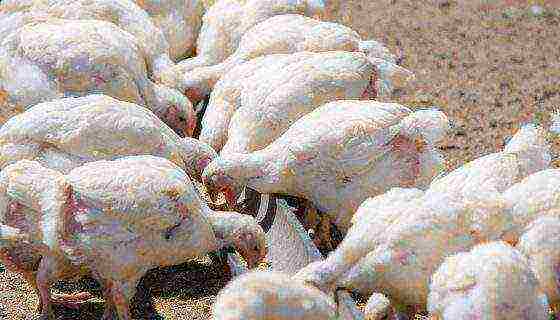
Proper cultivation of turkeys at home
With the proper approach, even a few birds can generate a small income. Many farmers do industrial business with turkeys, market meat, eggs, or raise young animals for sale.
At home, for beginners, it is possible to grow turkeys from scratch, the main thing is to approach this issue responsibly and calculate the profitability. Growing several crosses on a farm can be done by renting a plot and making several poultry houses. Before raising turkeys, you should study the full description of bird breeds, as well as watch photos and videos about all aspects of nutrition and maintenance. The price of a turkey starts from $ 5 for individuals, if translated into rubles, it will turn out to be about 300 rubles. How much a turkey costs, you need to look specifically in your region and take into account other features of the young.
Benefits of farming turkeys on a farm
An adult turkey grows rapidly and gains weight, poultry meat is distinguished by its high taste and dietary qualities, and has all the necessary components. A turkey carcass contains more than half the weight of the meat, the rest is fat, bones and entrails. Turkey eggs and colored feathers are highly prized. Poultry droppings become the strongest organic fertilizer - a flock of turkeys can fertilize fields better than any chemical fertilizers and does not accumulate in the human body.
For some people, raising turkey poults at home does not seem very profitable. Of course, keeping such large birds requires some effort, knowledge and useful skills. Some breeders find it difficult to raise poults and think that poults will die because they cannot adapt to a different habitat. But, fully providing all the necessary conditions for the living of turkeys, you can be sure that the most inexperienced owner will completely preserve his own livestock. Particularly vulnerable chicks before the first month of life require the most care, they need more attention and care than adult birds.
There is no need to worry that the chicks will get sick - timely treatment and vaccinations against especially dangerous infections will prevent the diseases of small turkeys and prevent them from dying. Pay attention to balanced nutrition and recommended nutritional supplements, which will lead to rapid growth and weight gain in chicks. So, they will grow significantly in a short time, and will soon become adult birds. Special recommendations for breeding turkeys allow you to resolve any disputes and ensure the good development of young animals by following simple recommendations.
Choosing a turkey breed
At home, mainly meat varieties of birds are grown. One such popular variety is the broad-breasted white. These are most often individuals of heavy crosses, which from the first month begin to actively gain weight. The weight of an adult male ranges from 25 kg, a turkey weighs about 11 kg. Another meat breed is the Big-6 turkey. This breed is considered early maturing and by 3 months it can weigh 5 kg. From egg directions, you can choose a variety such as a chiton. The breed is undemanding to breed and is suitable for novice farmers.
The chiton breed can produce about 100 eggs per year. Very beautiful plumage in a variety of turkeys, bronze broad-breasted. Many farmers start such an egg breed solely because of the pretty feather color. The bronze broad-breasted gives an average of 70 eggs per year. Egg breed white Moscow looks like a variety of big turkeys. The egg production of the Moscow breed is 105 eggs per year.Birds adapt well to various temperature fluctuations and easily adapt to new living conditions. Moderately whimsical and suitable for novice breeders.
Special habitat for turkeys
Where to start breeding turkeys and care from the first month in order to raise young animals without loss. The peculiarities of growing are that all the secrets lie in determining how the birds will be raised, and where they will be kept - it depends on the nature of the habitat and the goals of breeding the birds. Depending on them, there are various techniques for keeping turkeys. Such techniques are determined even before they begin to organize and build a poultry house.
Growing turkeys at home in an extensive way involves only raising young stock in the warm season - in the spring they are grown indoors, and until slaughter in an open pasture. The turkeys are provided with shelter from the rain - this canopy also serves them as an overnight stay. To use this method of breeding, it should be remembered that breeding 1000 individuals requires 4 hectares of land, which will not require additional fertilization when they will be cultivated next year.

Growing features depend on the breed
The outdoor method of keeping in a poultry house is quite common on farms, but provided that it is additionally insulated, it is equipped with enough light and spacious, and well ventilated. A place for walking birds must be attached to the poultry house. The cages contain small birds, young individuals and females that sit on eggs. They are equipped with tiers in the room, the corral is heated and provided with good ventilation.
Place for rearing young animals
For young animals, in particular, they equip a box, a small corral, or a spacious cage - the air in them should not stagnate in order to exclude the appearance of all sorts of ailments. Shavings are poured onto the surface of the habitat, and mandatory reusable ventilation is provided because the chicks have a very negative attitude to unpleasant odors and musty air. The temperature regime is at least 37 degrees, but as the chicks grow up, it constantly decreases.
Stable lighting and regular litter changes are essential. The bird's habitat is provided with all the necessary equipment and the presence of a heating device, a thermometer, which records the temperature. Although wild turkeys can withstand temperatures up to minus 15 degrees. In order to prevent poultry from freezing, the temperature regime is made at least 17 degrees, and turkeys should be provided with a heat of at least 32 degrees.
Growing turkeys
Sometimes, novice farmers wonder whether it is worth keeping different types of birds in one place to save space and how to raise turkeys in this case? Veterinarians advise to refrain from this step because different species of birds are prone to different infections, and their transfer from one breed to another can dramatically increase the number of diseases. In the event that you still have to keep different species of birds together, you need to build a fence in the room.
To grow turkeys at home to be productive, you should adhere to the following rules
- Establish a special microclimate in the house. For turkeys of the first month of life, moisture is inserted about 75%, and later at least 60%. To reduce the heating fee, the house should be thoroughly insulated, because individuals do not perceive sharp temperature fluctuations well and begin to get sick.
- Provide adequate lighting in the poultry houses - if there is not much light, the poults will simply not be able to find their own food. Adequate nutrition also has a positive effect on the physiological condition, weight gain and productivity of the bird. And when the turkey poults reach the age of one and a half months, it is enough to provide them with daylight hours for 8 hours, and the rest of the time they will rest.
- In order for turkey poults to grow strong and healthy, they need to be provided with adequate and regular nutrition. Their food should be fortified with supplements and vitamins, and green food is often given in summer.
- The nature of young birds should also be taken into account - like people, they can become depressed, and some individuals have a quarrelsome character and start fights all the time. The fighters themselves, their neighbors in the poultry house, often suffer from conflicts in the poultry house - squabbles can even affect their health.
- You should know that birds should be separated by age, and not kept in one pen more than it should be according to the standards for keeping individuals. Up to a month of life, no more than 15 individuals should be kept in one cage, from two months no more than 5-10 birds.
- Turkey poults should be provided with a full-fledged food, while do not immediately change the usual food ration - they negatively tolerate changes in food quality and may refuse food offered that they do not like.
- The key to healthy turkey poultry is good food, clean water, a cleaned poultry house and fresh air.
For the equipment of perches, they are fixed at a height of at least 80 cm, and they should lag behind each other by at least 40 cm so that the birds do not interfere with each other. Up to seven days of age, river sand should be used as bedding, and later that age, straw is used. It is poured over with boiling water for disinfection and dries well; such a bedding is replaced once every 7 days. If the litter is made of sawdust, then their layer should be at least 9-15 cm, and it itself should be without indentations in order to prevent the chicks from falling.
Until the age of five days, only soft feeders are used, from where turkeys with immature beaks can eat. For this, you can use a cloth. In addition to ensuring external conditions, attention should be paid to the chicks themselves, they should be mobile and keep well on their feet, their umbilical cord should be healed, and the fluff should be clean - choosing such chicks, you can be sure that they will grow up healthy and strong birds.
How to feed the birds?
How to raise turkey poults so that they always feel comfortable? To ensure a quick weight gain and growing of all turkeys, you should know what to feed the turkeys at home. To get healthy meat and eggs, you need to purposefully choose the diet of young animals. All components must be present in it. In the diet of turkey poults, cereals and legumes should be present - they should make up about 70% of the total feed. Fish, cottage cheese, herbs and potatoes are used as food additives, which are added immediately before serving and in small quantities. Small turkeys are fed 7 times a day, and older ones 4 times a day.
Adult turkeys are fed 3 times a day - in the morning or in the afternoon they are given herbal mixtures and herbs, at the end of the day, grain. The compound feed is mixed with herbs and given in a combined form. During the warmer months, turkey poults are grazed in the open, and greens are an excellent addition to the diet and a source of minerals and vitamins. Regular walks will help the bird to cope better and it will not grow fat. In the cold season, animal fats are added to the diet, which includes vitamins A and E, and to avoid vitamin deficiencies, farmers make brooms from branches and simply hang them in the house, or grind and add to feed. The diet includes green hay and occasionally the poults are fed sauerkraut.
Strong and healthy turkeys. Feeding and care.
TECHNOLOGY OF GROWING TURKEYS OF HEAVY CROSS BIG - 6 (Big - 6)
Turkeys - keeping and breeding turkeys - our experience
Turkey Poults - Growing Problems & Cases of Turkey Poults
Turkey poults BIG6 / care / maintenance / feeding / turkeys heavy cross BIG-6
How to Raise a Healthy Poultry. Chickens. Turkey poults.
The diet of turkey poults includes the following components
- Legumes and cereals.
- Soy branches and cake.
- Meat, bone, blood and fish flour.
- Fir or pine needles.
You should know that during the mating season, the appetite is disturbed in birds, and their cries are heard throughout the street. In order not to lose weight gain, males can be fed with cottage cheese, fresh herbs and grains can be added. Yeast and sprouted grains are added to turkeys to increase the number of eggs. The birds are watered with water at a comfortable temperature, which is changed every five hours, several times a week they are watered with a weak solution of potassium permanganate. Drinking bowls and feeders should be removed and wiped dry; they are not exposed to the sun, but only to the shade. Turkey poults are fed with oat flakes, corn flour and milk powder - gravel is poured into a separate bowl for them.
How to raise young turkeys at home? It is better not to place chicks together with individuals of other species of birds and you always need to keep clean and tidy and regularly change the litter. To raise small turkey poults, there is a technology, when choosing chicks, they pay attention to their activity and well-groomed appearance.
It should be remembered, although there is a lot of trouble with small chicks, you just need to regularly feed and give clean water, which is why they provide rapid weight gain and care will be easier. Often, turkey breeding starts as a hobby, and then it becomes a source of stable income and even a whole industry appears - it is only important to know all the intricacies of turkey breeding in a backyard and how best to raise daily turkeys from the first day. Having useful information, you can correctly calculate whether it is profitable or not, what kind of breeding scheme there is. With the right calculations, you can make good money on breeding turkeys.
Similar articles
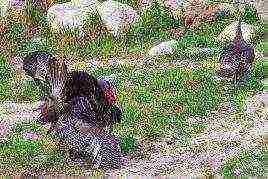
Reviews and comments
Growing turkeys is a responsible event that requires a careful and carefully thought-out approach. Compliance with the rules and implementation of recommendations gives a chance to cope even with a novice poultry breeder. The large size of the birds, the high growth rate, the active demand for turkey meat - make this occupation profitable. Before you buy the first batch of young animals or eggs, you need to prepare the place of keeping, stock up on feed, the necessary equipment; calculate the costs of the upcoming venture to avoid surprises.
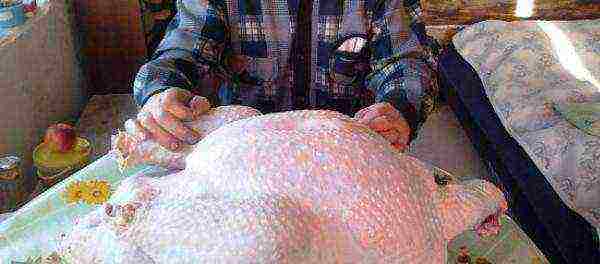
One broiler turkey is up to 20 kg of dietary meat
Arrangement of the place of detention
Many breeds of turkeys are adapted to cold winters, but keeping in a barn without insulation will not allow turkeys to survive the frost safely. Therefore, you should think about building a well-insulated and spacious poultry house. Basic requirements for the premises:
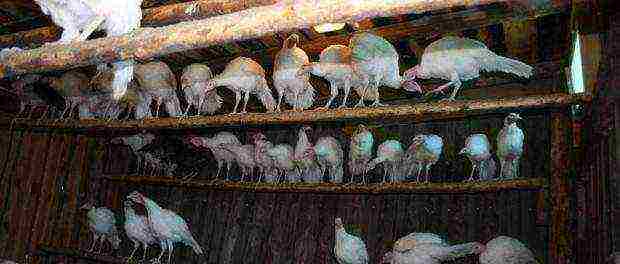
Broiler turkey poults on perches
- Large nests and perches. For one turkey, about 50 cm poles at a height of at least 80 cm from the floor. Nests are built 50 cm from the floor, at least 70 × 50 cm in size.
- Lack of drafts. The place for construction is chosen in a place protected from the wind. Insulated walls without cracks and holes.
- The presence of ventilation. The easiest way is a window, but it is not convenient in winter. If possible, the room is equipped with ventilation with a plug so that during ventilation the air temperature remains within normal limits.
- Dry floor. For temporary housing, wood shavings or straw are suitable. With constant, it is better to make a wooden, slightly sloped floor, with insulation.
- Feeders and drinkers. For wet feed, steel or plastic containers are suitable; for dry ones - made of wood.

It's easy to build a poultry house
For the warm period, a corral is built: the walking enclosure should be spacious, at least 2 m2 per bird. It is fenced off with a net so that the birds do not scatter. It will also be a precautionary measure against predatory animals.
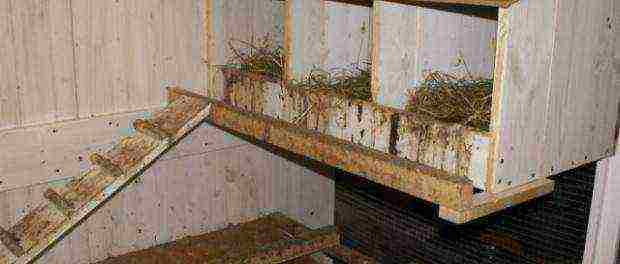
Laying turkeys need closed nests
Raising chicks
Having arranged a room for turkeys, they begin to purchase the first livestock in the form of eggs or young animals. When buying eggs, an incubator is additionally purchased. After hatching, the chicks require special conditions of detention.

Properly organized place for turkey poults
Basic environmental requirements
Chicks of turkeys require close attention and care. Immediately after their appearance, they are placed in a separate place: joint keeping with chicks of other species is not allowed. Turkeys' poor eyesight causes faster bird species to eat their food.
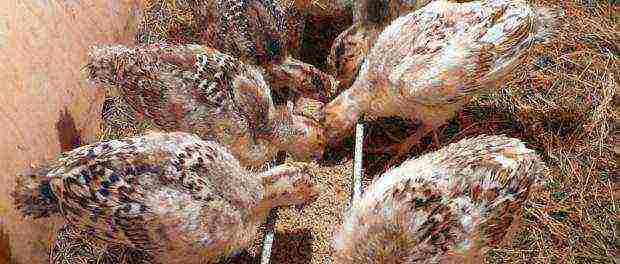
Grown turkey poults can be transferred to feed
The first time after birth, turkey chicks need an elevated air temperature of at least 37 ° C, so the best option would be to isolate them from the adult livestock. The air temperature is gradually reduced by about 1 ° per day. The behavior of the chicks will help to determine more accurately: if it has not changed, then everything is in order. The heating system is bought or assembled independently. The building for keeping chicks is called brooder.

Ready brooder for keeping turkey poults
It is a box with mesh walls, equipped with heating, lighting, feeders and drinking bowls. If you have the skills to work with building materials and electrical wiring, it is made by hand.
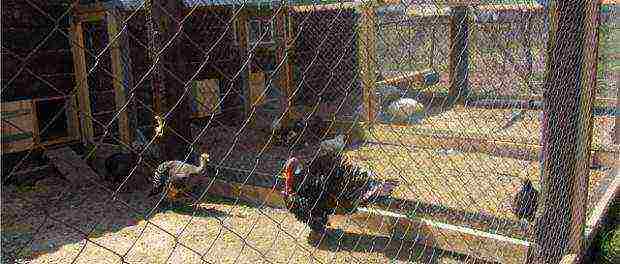
Open enclosures are compulsory
Turkey poultry
Chicks bred in an incubator without the participation of a hen are helpless at first, they need to be taught to eat. In order for the chick to understand how to drink, its beak is dipped in water. To teach him how to eat, they tap the feeder with a finger, imitating the sound with which an adult turkey pecks on grain. The type of feed is determined by the owner: it can be ready-made combined feed purchased at the store. You can also cook food for the chicks yourself: in the first days they give a boiled egg, cottage cheese; then the crops are gradually added. For the first 7 days, feed is given every 3 hours. A bowl with low sides is used as a feeder, but always made of soft material (for example, a lid from a cardboard box).
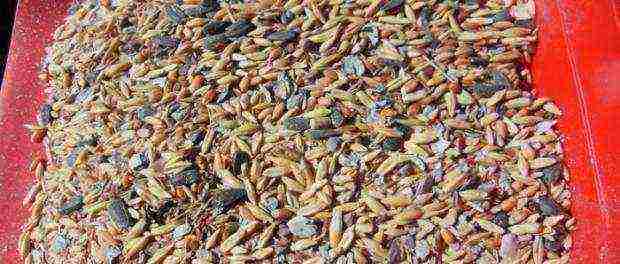
Mixed food for turkey poults can be given from 10 days of age
From the second week, finely chopped boiled vegetables, as well as chalk, bone meal and charcoal, are introduced into the diet. Be sure to include green grass in the diet, but only finely chopped. Water plays an important role in the healthy growth of chicks: it is changed several times a day.
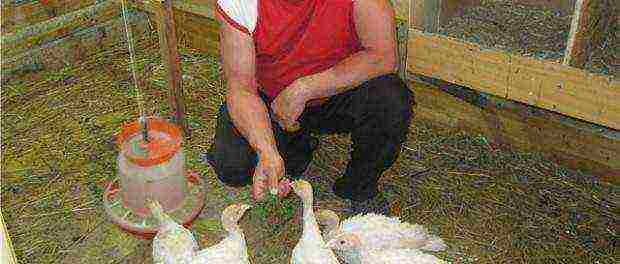
In addition to the availability of feed, turkey poults must always have clean water.
It is unacceptable for chicks to drink dirty water with specks and debris. Drinkers are regularly cleaned of dirt and lichens.
Chick health
In order to minimize mortality among livestock, and to avoid an outbreak of infection, you should take care of veterinary services and necessary vaccinations in advance. If the clinic is too far away, it is necessary to be aware of common diseases among turkeys. They also collect a first-aid kit with medicines, and study in advance how to use them in case of a chick's illness.
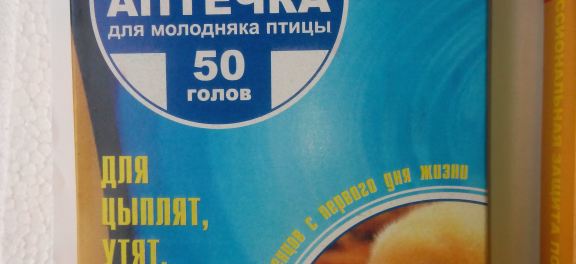
A veterinary first aid kit for chicks is a must
Keep the house clean to prevent infection. To do this, they regularly disinfect it, and also process feeders, drinkers, and tools for work. Do not leave old feed in the feeders, this can lead to its rotting, and cause a wave of infection among the herd. For the same reason, young animals are settled separately from adult birds: having pecked at the feed that has fallen from the feeders, they risk getting an intestinal infection.
Care of grown turkeys
Growing turkeys at home becomes easier as the bird matures. In the summer, they are transferred to grazing in a corral, where they can provide themselves with additional food in the form of various insects, caterpillars, larvae and worms. The bird continues to be fed with cereals, vegetables, cottage cheese and herbs. If the turkey is bred for meat, then the feed should be sufficient for an enhanced set. At the same time, this should not lead to obesity, which will spoil the turkey meat, therefore, when feeding, they adhere to the following scheme:
- dry combined feed and grain are given in the morning and in the evening;
- for lunch, they give mash-ups with a lot of greens;
- in winter, the bird is fed only grain.
An approximate diet of turkeys per head
The diet of adult turkeys continues to include chalk, salt is added and the amount of bone meal is increased to 2.5 g per individual.
For turkey meat to be of good quality, you need to create a balanced diet that includes:
- proteins found in grains and fresh beans;
- fats, but not more than 7%, otherwise the growth of the bird will slow down;
- carbohydrates found in grains and greens;
- fiber no more than 9% of the total diet - it improves digestion;
- mineral elements and vitamins.

Jerusalem artichoke is an excellent vitamin supplement to feed
During the breeding season, males reduce feed intake in the daytime, so they are additionally fed with raw beans and carrots, and the females are given additional vitamin complexes. If turkeys are raised for meat, it is important not to skip slaughter dates: females are slaughtered at 16 weeks of age and males at 22 weeks of age.
Turkey meat breeds
When raising turkeys for meat, breeders prefer to purchase hybrids that have impressive growth and weight gain. Common breeds:
- Hybrid Converter. Heavyweight meat breed with excellent meat taste. The weight of a turkey reaches 24 kg, turkeys 11 kg.
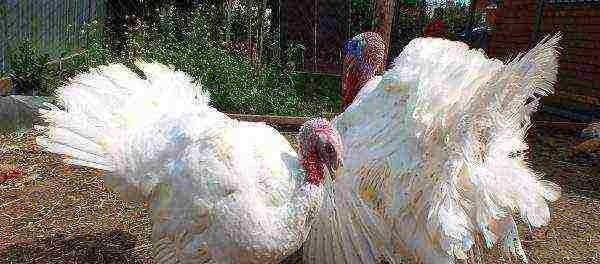
Highbread Converter turkeys reach 22-25 kg in weight
- BYuT-8. A relatively new heavyweight species, the weight of the male reaches 27 kg, the female 10 kg.
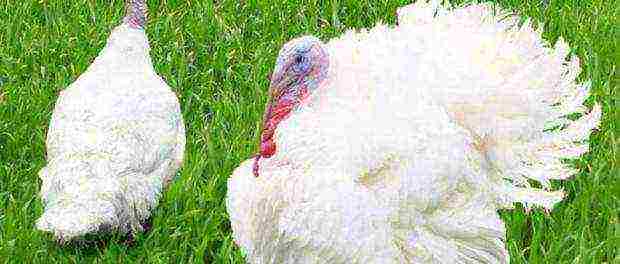
BYuT-8 turkeys are distinguished by their unpretentiousness
- BIG-6. They occupy a leading position in the lists of the best meat breeds, gain weight quickly, and retain the excellent taste of turkey meat. The weight of the male reaches 24 kg, of the female 11 kg.
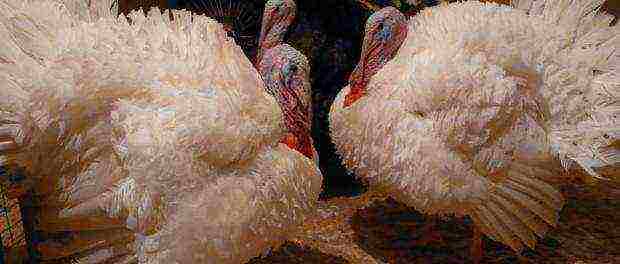
BIG-6 turkeys are the most common broiler breed in our country
- Station wagon. Differs in increased vitality, soon ripens for reproduction. The weight of a turkey is up to 18 kg, a turkey is up to 10 kg.
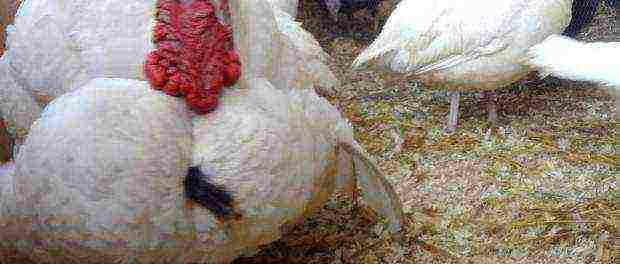
Turkey and turkeys of the Universal breed
- Bronze broad-breasted breed is suitable for keeping beginners, as it is distinguished by good vitality of young animals. On average, a turkey reaches 19 kg, and a turkey 12 kg, but with longer care, an individual reaches more than 30 kg of weight.
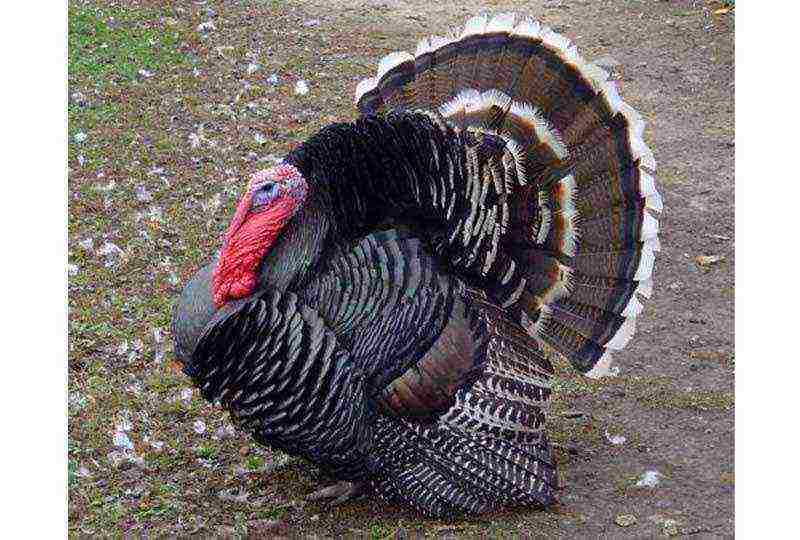
Bronze broad-breasted turkey breed can gain up to 30 kg of mass
When choosing young poultry, novice poultry breeders need to be guided by the appearance: chicks should be active, have a smooth clean fluff, as well as a dry tail and umbilical cord. The droppings should not have a liquid consistency.
Financial expenses
Breeding turkeys for meat is a profitable activity if properly organized, so it is important to estimate the costs in advance.
- The construction of a small poultry house for several dozen heads will cost about 30-40 thousand rubles. Consumption will be reduced if you have a barn that can be rebuilt for a poultry house, equipped with heating and ventilation.
- With the initial cost of a brooder from 5 thousand rubles, and an incubator from 2 thousand rubles, at least 7 thousand rubles should be added to the costs.
- A turkey egg costs from 60 to 100 rubles, young animals about 150 rubles per individual. When buying 20 eggs, you will need at least 1200 rubles, and 20 pieces of chicks - 3000 rubles.
- Average feed consumption per female: 3 kg per week; for a male - 4 kg per week. The average cost of feed is 30 rubles per 1 kg. Thus, a herd of 20 heads with an equal ratio of males and females, and their rearing up to 16 weeks and 22 weeks, respectively, will require 62.4 thousand rubles for feed.
First you need to develop a business plan for breeding turkeys.
Removing 20 chicks from eggs using an incubator, and their further maintenance will require approximately 112 thousand rubles for the entire period before slaughter. The average cost of 1 kg of turkey meat is 300 rubles. With 10 kg of female weight and 20 kg of male with 20 individuals, you can get up to 90 thousand rubles of income. Additional money can be obtained for the eggs of hens or young animals hatched in an incubator: some breeds carry up to 100 eggs per season from one individual; and also for down and feathers.
The initial stage of breeding will require financial investments, but with the right organization, it will quickly pay off.
At home, you can start an enterprise with a small herd, and if it is productive, then gradually expand it to the required volume.
The turkey can be considered one of the most interesting types of birds raised in households. Their meat is distinguished by simply excellent high taste and is considered dietary.Growing turkeys at home can have its own nuances and difficulties.  Breeding chickens, for example, is much easier. However, you can get much more meat from one turkey than from a rooster.
Breeding chickens, for example, is much easier. However, you can get much more meat from one turkey than from a rooster.
You can, of course, use an incubator to breed turkey poults. However, no one can cope with this task better than a brood hen. Growing turkey poults at home begins with preparing a nest for her. It is quite simple to make it. This will require 2 bars of 10 x 10 and hay. The nest is arranged in the corner of the barn. Bars are stuffed onto the floor and the resulting niche is covered with hay.
Better to lay eggs under the hen in the evening. At this time, when a person appears, she does not worry and does not jump off the nest. Turkeys are very caring mums and do a great job of hatching, turning the eggs over as needed for better heating. 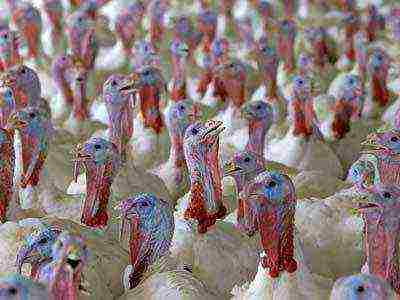 Chicks hatch at about 28 days. They begin to come out from under the hen only on the second - third.
Chicks hatch at about 28 days. They begin to come out from under the hen only on the second - third.
Growing turkey poults at home is different in that the first 14 days of life they require increased attention. Feed them at this time at least seven times a day. To do this, use millet, eggs, grated cottage cheese. It is very good to give small chopped herbs to babies, the taste of which is bitter. This will prevent intestinal disruption. The water must be changed at least two to three times a day.
Maintaining the optimal temperature is very important in such a complex matter as raising turkey poults at home. Directly at the floor, it should be at least 26 degrees Celsius. Also, you can not pour cold water into drinking bowls. You can only use water at room temperature. In addition, the drinkers themselves should not be too deep. A wet turkey will certainly get sick, and it is very problematic to cure these birds.
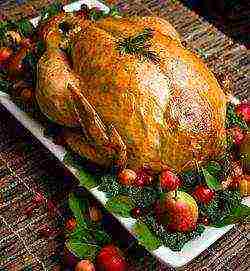 As they grow older, the diet is diversified and the number of feedings is reduced. Grown turkey poults will have enough 3 - 4 meals a day. However, during this period, it is imperative to monitor the condition of the chicks. If one of them sits for a long time with closed eyes and drooping wings, this may mean that he has a stomach ache. You can cure such a turkey by putting a small pea of ordinary unscented black pepper in its beak deeper.
As they grow older, the diet is diversified and the number of feedings is reduced. Grown turkey poults will have enough 3 - 4 meals a day. However, during this period, it is imperative to monitor the condition of the chicks. If one of them sits for a long time with closed eyes and drooping wings, this may mean that he has a stomach ache. You can cure such a turkey by putting a small pea of ordinary unscented black pepper in its beak deeper.
Feeding turkeys is a very responsible process. Adult birds in the winter period 2 times a day impose a mash (greens, bran) and once grain. During the breeding season, that is, in summer, the number of feedings is increased up to four times. In this case, both the grain and the mash are given 2 times. Particular attention should be paid to feeding the turkeys. They are very sensitive to vitamin deficiencies. Therefore, appropriate preparations must be added to the feed.
Growing turkey poults at home is not an easy task. However, by showing maximum attention to the chicks, especially in the first fourteen days, you can do absolutely without any losses.

